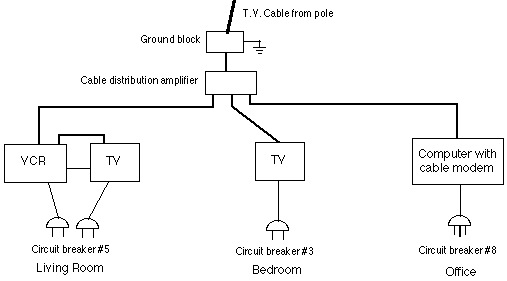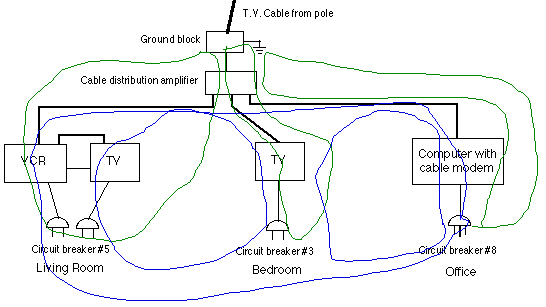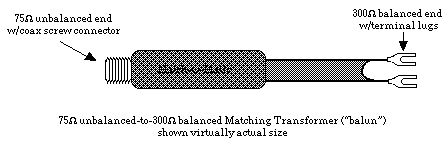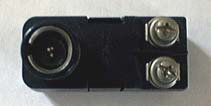
Originally Web posted 24 September 2000
Content last modified
Saturday, 9 January 2021
External links last verified Sunday, 30 January 2005
Goal: ensure that each device has zero or one (preferably one) path to earth ground.
Now that you have collected information about which devices in your systems are potential contributors to ground loops, you are in the position to take action to cure them.
One good way to come to terms with the situation is to make a simple block diagram of devices throughout the house which could form ground loops. Specifically, be sure to include any and all devices which your tests have show provide electrical continuity to other, remote devices, outside of the ubiquitous powerline connection. To avoid unnecessary clutter, only draw in the connections capable of passing ground loops.
Here is an example of several systems in different rooms tied together both by the powerline and by the common CATV cable:

In this hypothetical example, there were (an amazing) five televisions, two with VCRs, plus two computer systems with cable modems. Only two of the video systems (one with a VCR, the other just a TV) and one of the computer systems were found to be able to contribute to ground loops, per the tests of the previous page, so only these systems were drawn, for clarity.
In the drawing, the thicker lines represent the coaxial cable of the CATV system, and the thinner lines are either power cords or standard “RCA phono plug” shielded interconnect cables, for either audio or video. Note that even though the actual TV-VCR hookup will have at least three of these cables (Left audio, Right audio, and Video) and possibly more, the tests showed that any one of these could form a ground loop, so only one need be drawn, for simplicity (and it does not really matter which one is represented in the drawing).
Next, draw in the possible ground loops, in some easily visible manner (drawn in different colors here):

Yes, it’s messy…ground loops usually are! The green loops are attempting to show that each system, all by itself, forms a loop between the powerline and the cable. This is thanks to the mandatory grounding of the CATV cable as it enters the house[1].
The blue loops are attempting to show that, even if the cable line to the pole and the mandatory cable grounding block are disconnected, each pair of connected A/V systems still forms its own ground loop.
Now it’s time to carefully scrutinize the situation, and start choosing changes to form an overall solution.
The following considerations guide this process:
Since we know that making any ground loop-breaking changes to the A.C. power cord/powerline side of the loops is both illegal and unsafe, consideration A above reminds us that we can forget about any changes here. In this example, that means that our remedies will be confined to modifying the cable hookups.
Looking again at the diagram, we see that most of the loop lines congregate along each of the individual cable feeds to each A/V/computer system. In fact, if my drawing had not been so sloppy, one could more easily see that each of these individual feeds supports 3 ground loops: two blue, one green. So, if there were some way to isolate each of the A/V/computer systems in terms of ground continuity, yet still allow the full desired cable signals to pass, that should break all the ground loops and cure the problems. Is there such a device? Yes….
An isolation transformer is a device which, in the case of cable signals, allows all the desired signals to pass freely, while interrupting ground continuity, hence breaking ground loops. As i am presently both lazy and busy, you will need to refer to other websites for details on what is readily available in the way of CATV isolation devices. Besides using the usual search engines, try ferreting around these sites:
FAQ - Ground Loops
Ground loop problems and how to get rid of them (somewhere on this site is information on both building and buying isolators).
When seeking information on isolation transformers for CATV systems, be aware that there are several other devices used in electronics which are also called “isolation transformers” which are of no use on CATV systems. Most commonly, there exist A.C. power isolation transformers. In addition to being big, expensive, and sometimes noisy, these will NOT break the A.C. powerline path portion of the ground loop.
Rich P. was kind enough to forward some information regarding one ready-made isolation device: Calrad 75-504 D.C. Ground Blocker and Isolation Transformer. Rich goes on to write:
Unfortunately none of my local stores carry the CALRAD products, so I will have to mail-order it. It is available from Cables & Connectors Inc. as stock No. 2118.
When i need cable isolation, instead of seeking out (or making) a one-piece CATV isolation transformer, i prefer to use the much more common and inexpensive, off-the-shelf impedance matching transformer, or “balun”:

One of these alone will not do the job. In fact, it will totally mess things up: not only does it have the wrong kind of connector (the wires with spade lugs) on one end, the electrical impedance at that end is incorrect to match the cable. Two of these are needed, connected back-to-back:
![]()
Important: at least one of the two matching transformers MUST have No D.C. continuity between the threads on the “F” connector and the spade lugs. (It is OK if both of the matching transformers block continuity). Use your continuity checker and make sure this is true, otherwise nothing will be accomplished and the ground loop(s) will remain!
Here are some makes and models reported by readers of this site which have D.C. continuity from threads to lugs:
Please note that, while these two products together will not provide the necessary D.C. isolation, either one with some other isolating device will work. And these items will very likely work fine for use as intended by the manufacturer.
While entirely satisfactory from an electrical standpoint, having threaded F connectors on both ends of our made-up isolation transformer may require other adapters and/or connector changes. To avoid this, try to use:

Connect the two together, like this:

This arrangement may easily be plugged in between the end of the CATV cable and the VCR or TV or computer cable modem etc. with no other adapters nor connector modifications needed. Be sure that this overall assembly does NOT have continuity between the F connector outer shells! Otherwise, as noted above, the ground loop is not broken. Do not take anyone’s word for whether or not a particular device isolates cable shields - measure it yourself, always.
In the example, three of these assemblies would be needed to break all known ground loops. Whether or not all three would actually be required to cure problems in a particular installation is unpredictable, as not every ground loop will cause problems. Each of the three assemblies could be installed at the VCR/TV/computer modem end, or at the cable splitter end, whichever is more convenient (and it is not necessary to make the same choice for each system).
This concludes Sonic Purity’s half-baked attempt at helping you cure your ground loop woes. Hopefully, something here was helpful to you. Someday perhaps i will either improve these pages, or remove them and only refer folks to more thorough treatises on other sites.
Here is my entire collection of ground-loop-related sitemarks:
Ground loop problems, and how to get rid of them
Ground Loops, or 'Let Me Hum A Few Bars' [SMR]
FAQ - Ground Loops, video hum bars, audio buzz
Grounding Affects Noise & Safety (Yamaha Pro Audio)(link broken by Yamaha and too hard to re-find on their awful website… Good Luck!)
Antenna isolator building
When i tried a Google search as i wrote this in late September 2000, i found many tens of decent-looking ground loop-related websites… nearly one hundred, in fact. As noted at the beginning of these pages, feel free and encouraged to keep searching for more information on ground loops. I am truly sorry that time, resources, and personal knowledge limitations preclude these pages here from being more thorough and comprehensive. Because none of the sites i visited was oriented to the non-technical homeowner, i decided to put these pages up anyway.
In the future, we can only hope that, like SCSI and Wintel Com port IRQ dip switch madness, metallic cabling from the CATV company, the telephone company, and long loops in our own homes, disappears. Since optical fiber has no D.C. continuity, it cannot and does not form ground loops, no matter what. With its excellent immunity to lightning and other electromagnetic interference/damage, plus vastly superior bandwidth, it truly performs head-and-shoulders better than any metallic cabling. We can only pester our local government right-of-way gate trolls and fiber entrepreneurs, and hope that it reaches our homes sooner rather than later. Apparently some folks around Sacramento, California are already so lucky, thanks to SureWest.
1 Actually, conscientious cable installers who truly follow Article 820 of the N.E.C. are doing everything possible to minimize these loops. 820-40(b)(1)(1996 edition) requires that the cable shield ground connection as it enters the house be made to the existing building grounding electrode system, i.e. the house wiring conduits (if metal) or water pipes (if metal), or similar (see the actual N.E.C. for important, correct, precise details). While decidedly safer and somewhat less likely to yield major problems, even these fully legal installations still form ground loops, which often are still able to create annoying hum and/or other problems.
Did you somehow land here first? Begin at: What is a Ground Loop and why should I care?